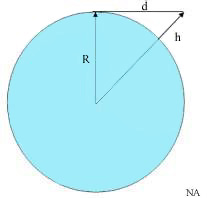A Line of Sight (LOS) calculator is a tool that helps determine the maximum distance between two points where a direct, unobstructed line of sight is possible.
This calculation is particularly important in fields like telecommunications, radio broadcasting, and even drone flying, where communication relies on clear, direct paths between transmitters and receivers.
This article provides an easy to use calculator with examples, background information, formulas, applications, and limitations of line of sight calculators.
Table of Contents
Calculator
To find the range, enter the heights of both the Transmit and Receive antennas.
Formula
The Line of sight distance is given by
d = 3.57*(√h1 + √h2)
where
- d is the vacuum distance
- h1 and h2 are the antenna heights

The Radio Horizon service range is given by
dr = 4.12*(√h1 + √h2)
This equation includes the effect of atmosphere on the propagation path of RF signals.
Example Calculation
Suppose you have two antennas, one at a height of 30 meters and the other at 50 meters. Using the calculator the LOS Distance ≈ 44.8 km
So, the line of sight distance between these two points is approximately 44.8 kilometers or 27.84 miles
The service range is a little longer at 51.70 km or 32.12 miles.
Background
A radio line of sight (LOS) calculator is commonly used in RF, wireless and telecommunications engineering design and planning.
In telecommunications, for example, LOS calculations are utilized for planning the placement of communication towers or antennas. A clear line of sight is often necessary for optimal signal transmission between two points.
The LOS calculator typically takes into account the Earth’s curvature, terrain, and any obstacles (such as buildings, mountains, or vegetation) that may obstruct the direct line of sight. Engineers and planners use these calculators to ensure that communication links or surveying measurements have a clear and unobstructed view between the specified locations.
Factors Affecting Line of Sight
Several factors can affect line of sight and the reliability of your signal:
- Curvature of the Earth: Over long distances, the curvature of the Earth comes into play, which is why taller antennas can extend the line of sight.
- Physical Obstacles: Buildings, trees, hills, and other structures can block or degrade the signal. Even if antennas are tall, objects in between can interfere with clear communication.
- Weather Conditions: Rain, fog, and atmospheric conditions can scatter or absorb signals, reducing the effectiveness of communication systems even if there is a clear line of sight.
- Fresnel Zone: The Fresnel zone is an elliptical area around the direct line of sight that must also be free of obstructions. Even if the direct line of sight is clear, objects within the Fresnel zone can interfere with signal strength.
How is the Line of Sight Calculated?
Referring to the picture below

- d = Line of Sight Distance
- h = Antenna Height
- R = Radius of the Earth
Using Pythagorean Theorem
(R+h)2 = d2 + R2
d2 = (R+h)2 – R2 = 2*R*h + h2
since h is small relative to R, d can be approximated as
d = √(2*R*h)
The Radius of the Earth is 6370 km and therefore
d = √(2*6370*h*0.001)
d = 3.57*√(h)
where h is specified in meters and d is in km.
Atmospheric Effect on the Radio Horizon Calculation
The common consequence of the atmospheric pressure decreasing with height (vertical pressure variation) is the refraction or bending of radio waves toward the Earth’s surface.
This phenomenon leads to the creation of an effective Earth radius, typically augmented by a factor of approximately 4/3. This augmentation, referred to as the k-factor, reflects an increased effective radius for radio wave propagation.
The maximum service range is therefore
dr = √(2*R*h*(4/3))
dr = 4.12*√(h)
It’s important to note that the k-factor is not static; its average value may fluctuate based on prevailing weather conditions. Factors such as temperature, pressure, and humidity variations in the atmosphere can influence the k-factor, leading to dynamic changes in the bending of radio waves and, consequently, alterations in the effective Earth radius.
The formula above applies in the case of normal weather conditions.
This variability underscores the significance of considering real-time atmospheric conditions when assessing the range and performance of radio communication systems. For instance under certain adverse weather conditions k can be less than 1.
